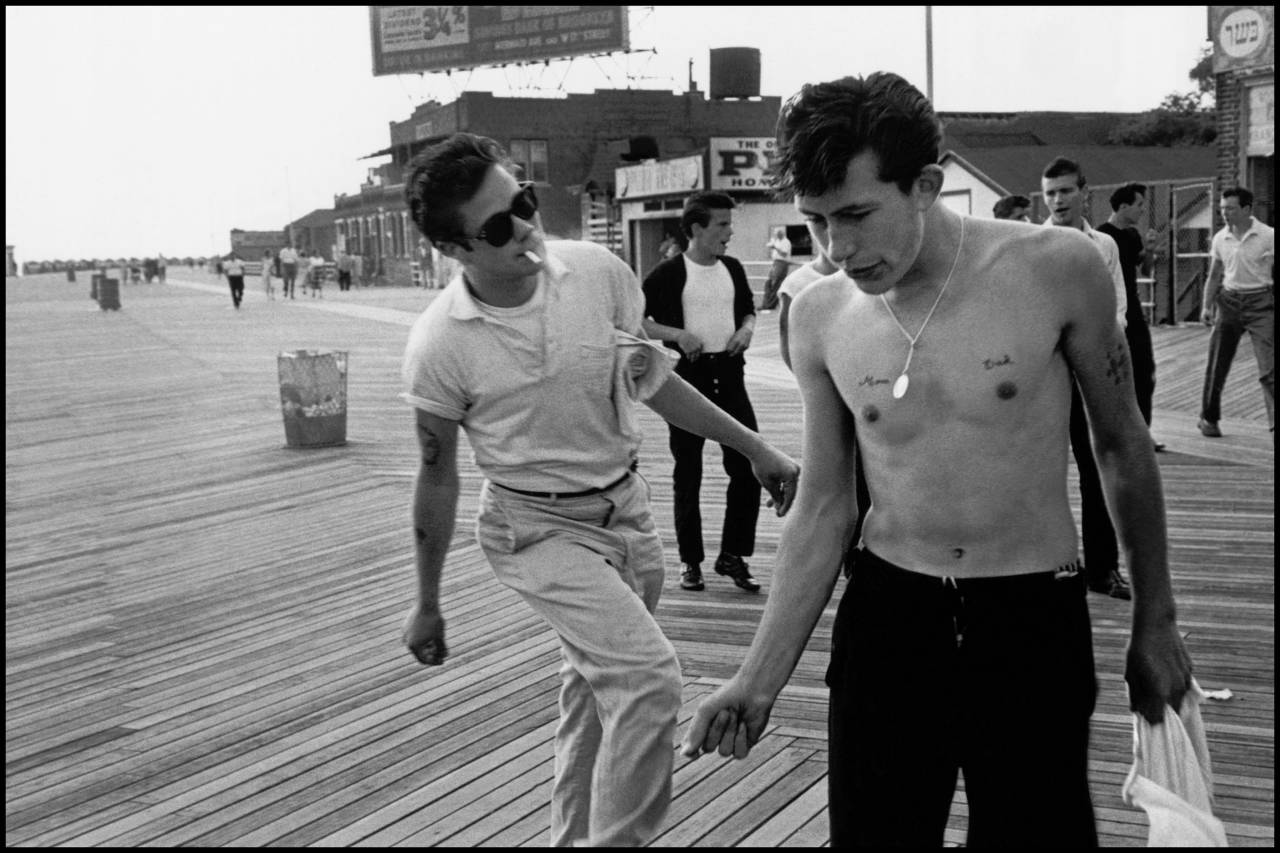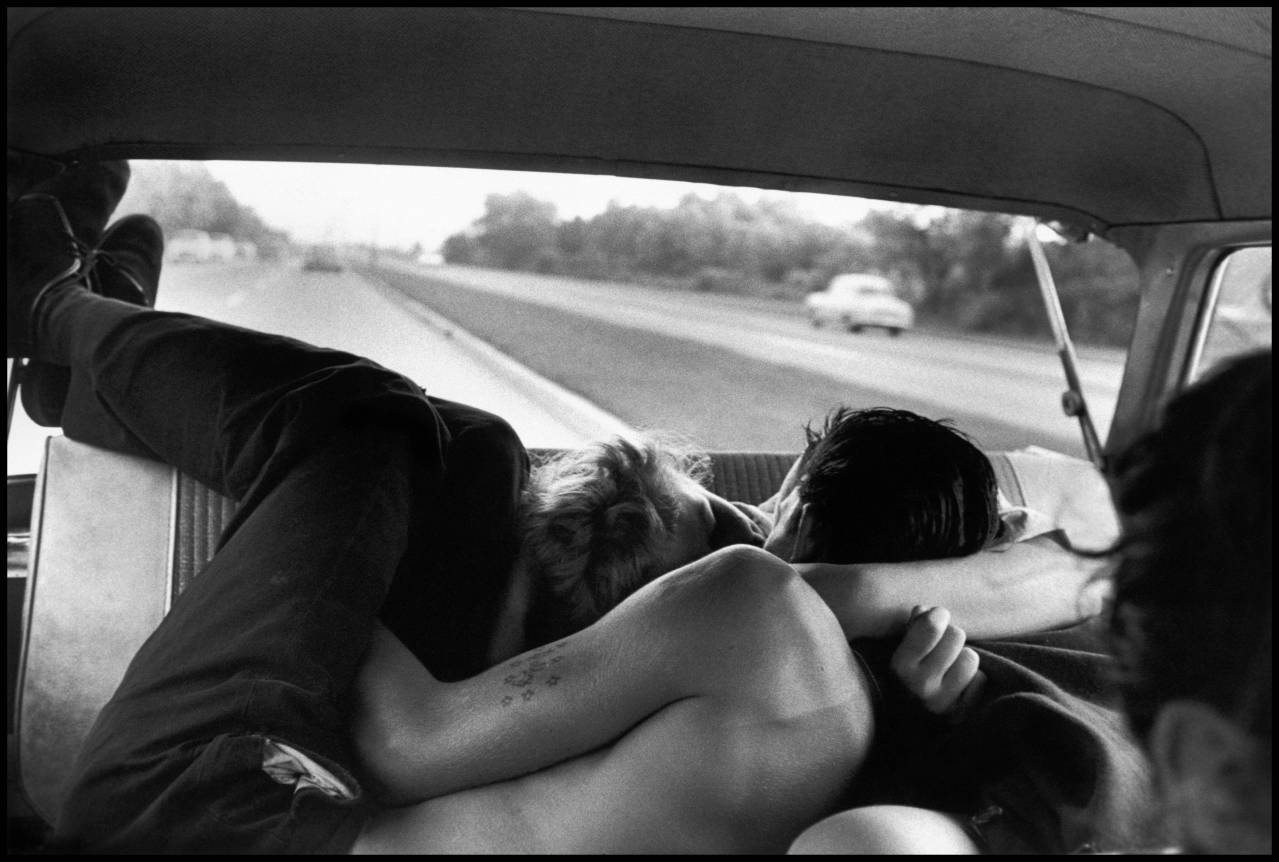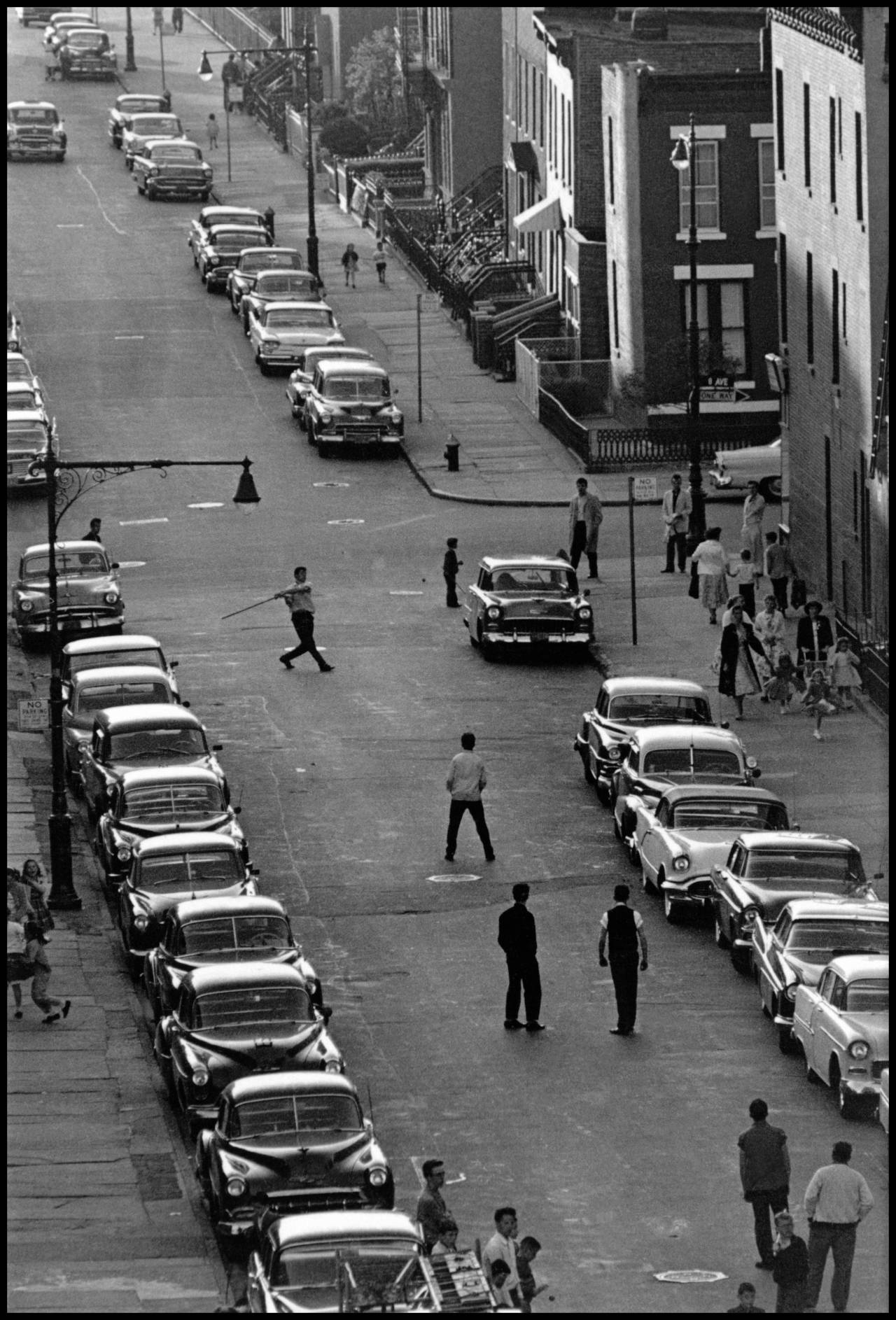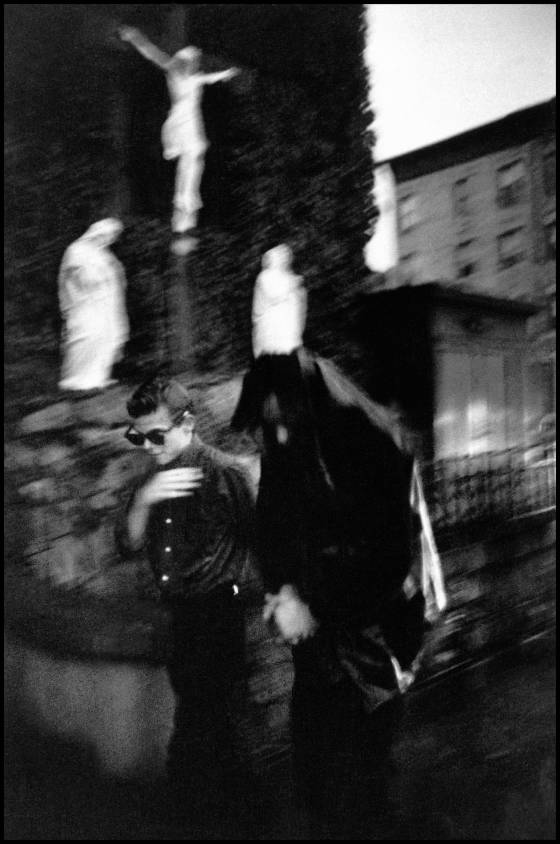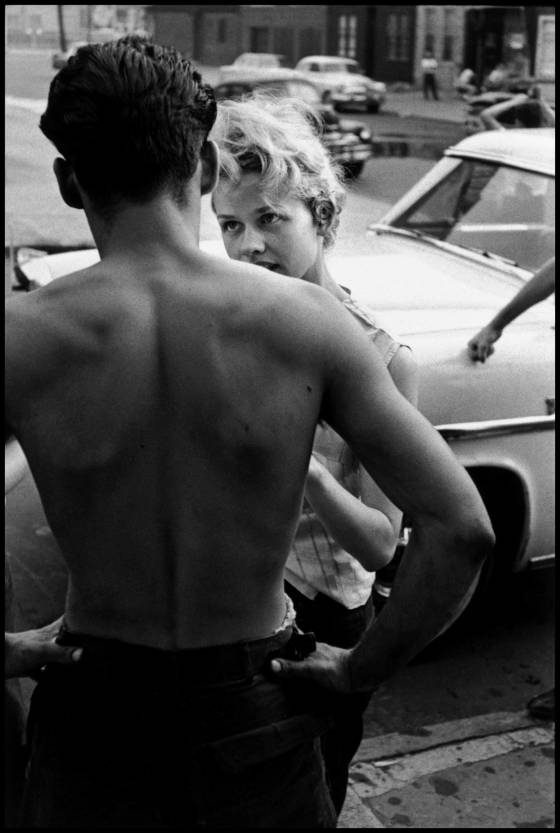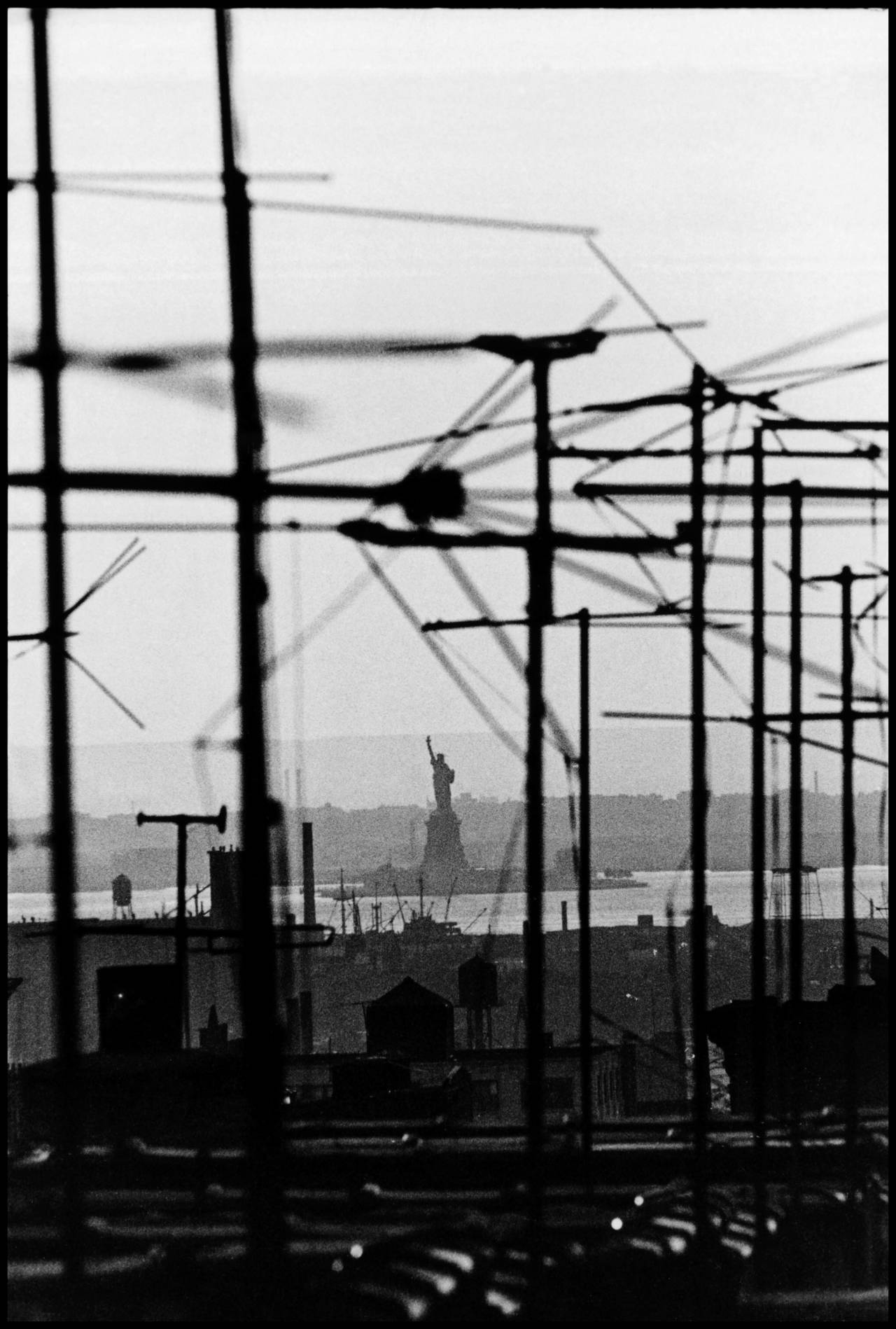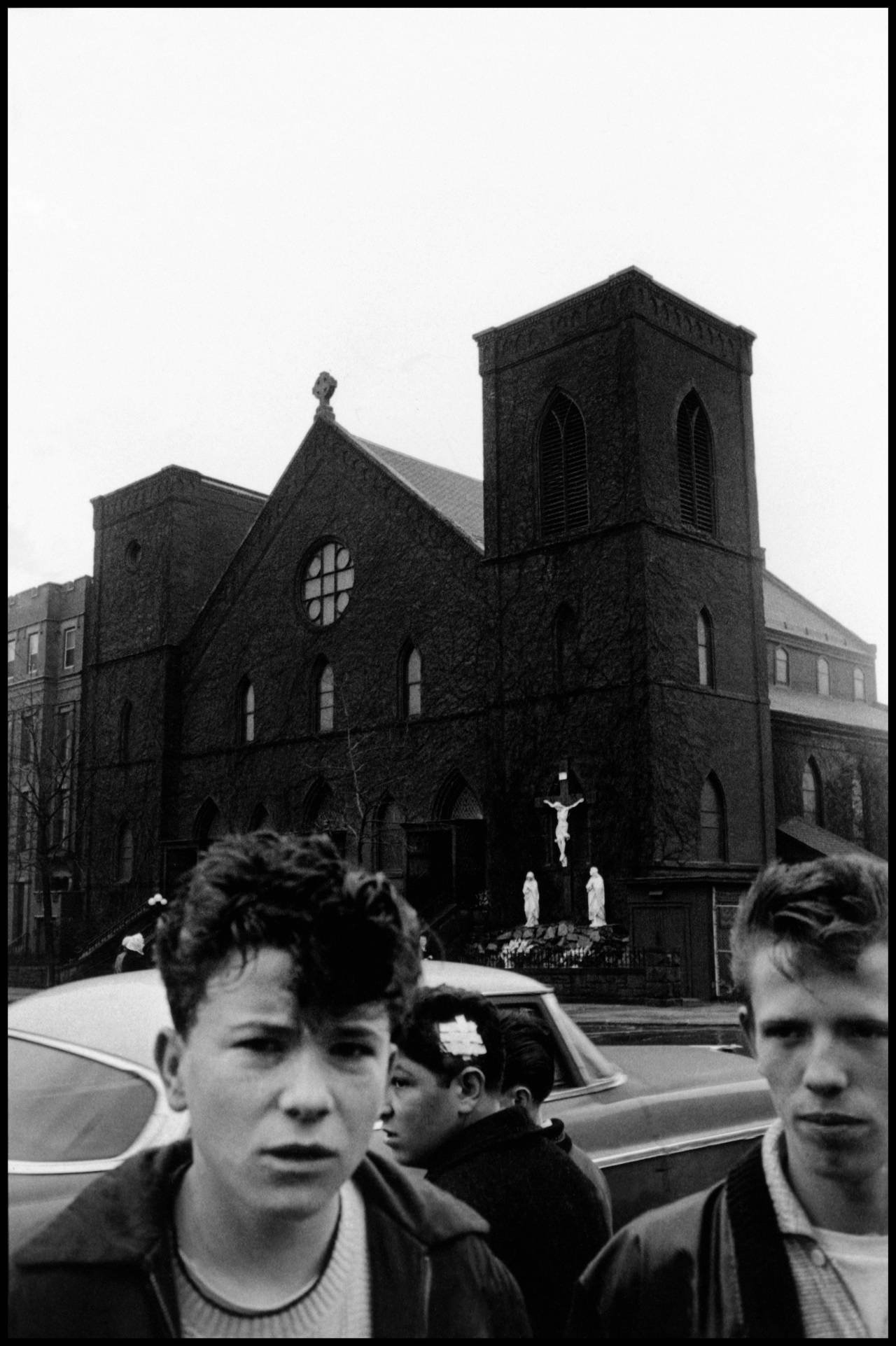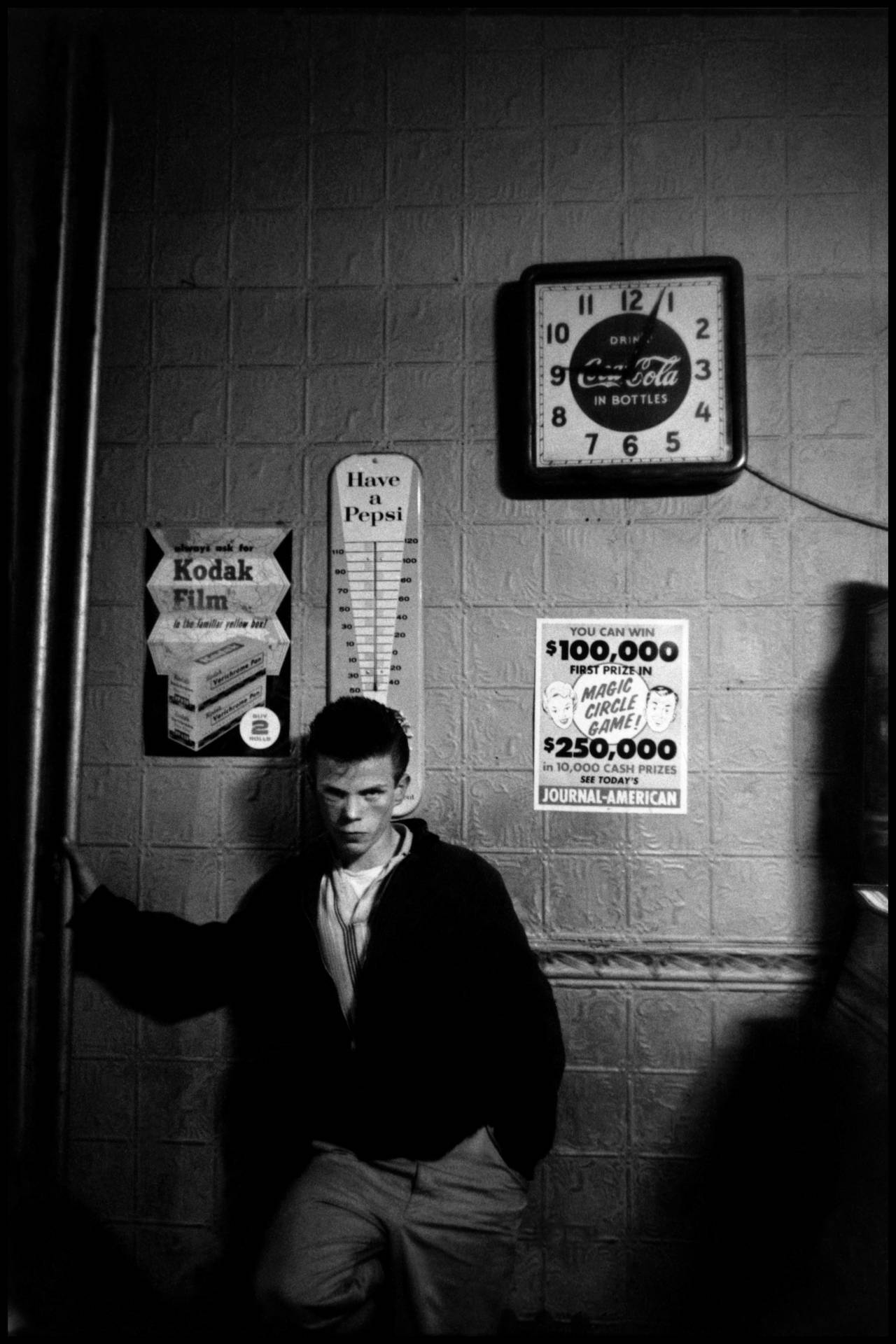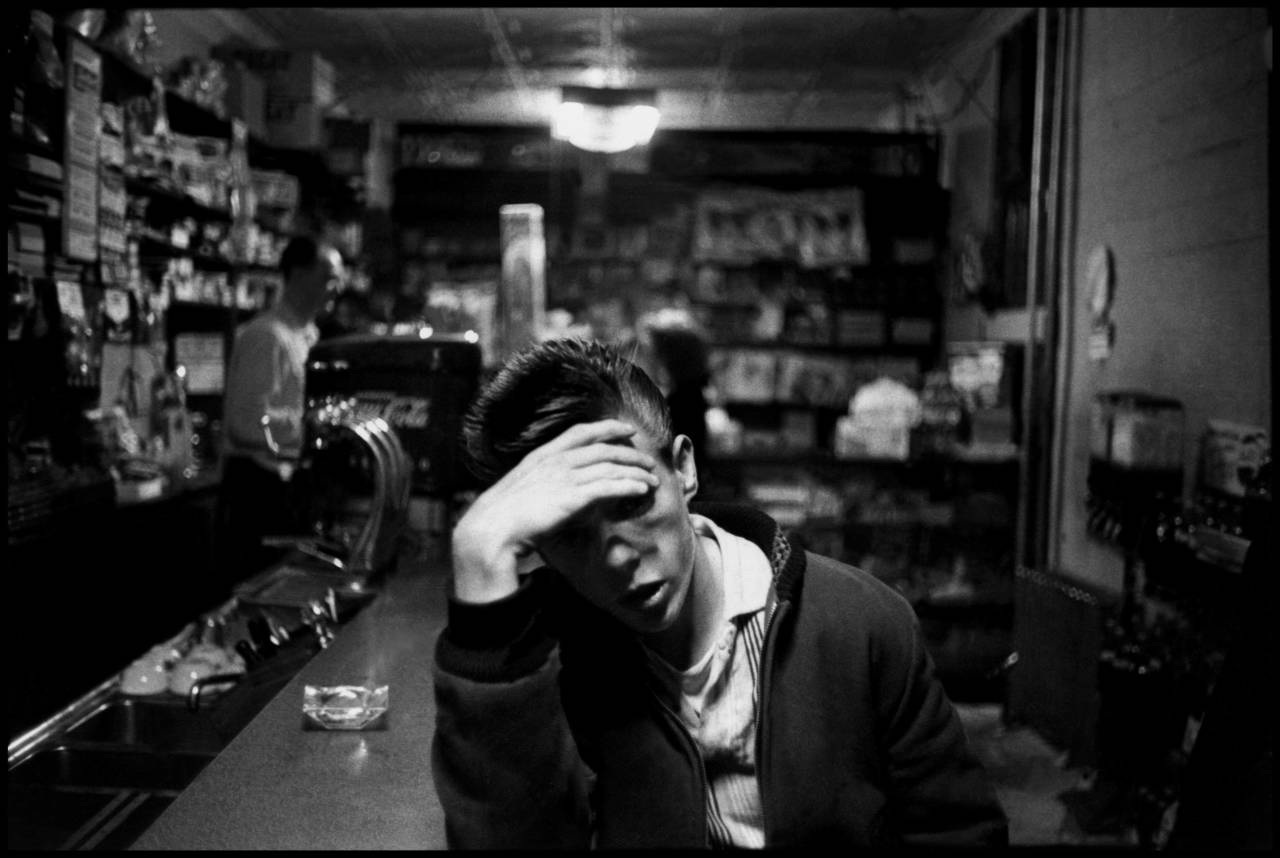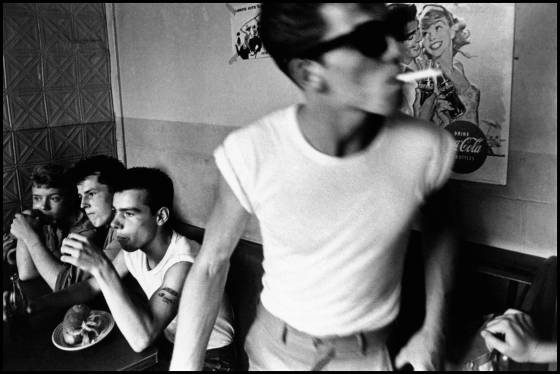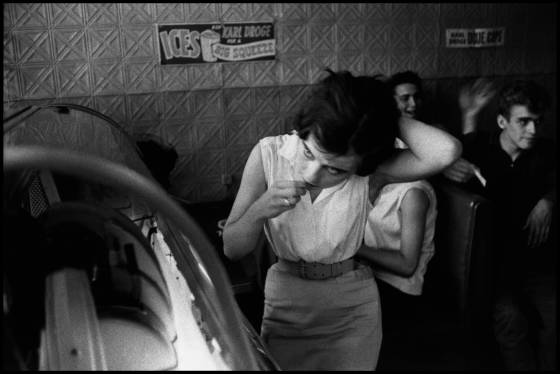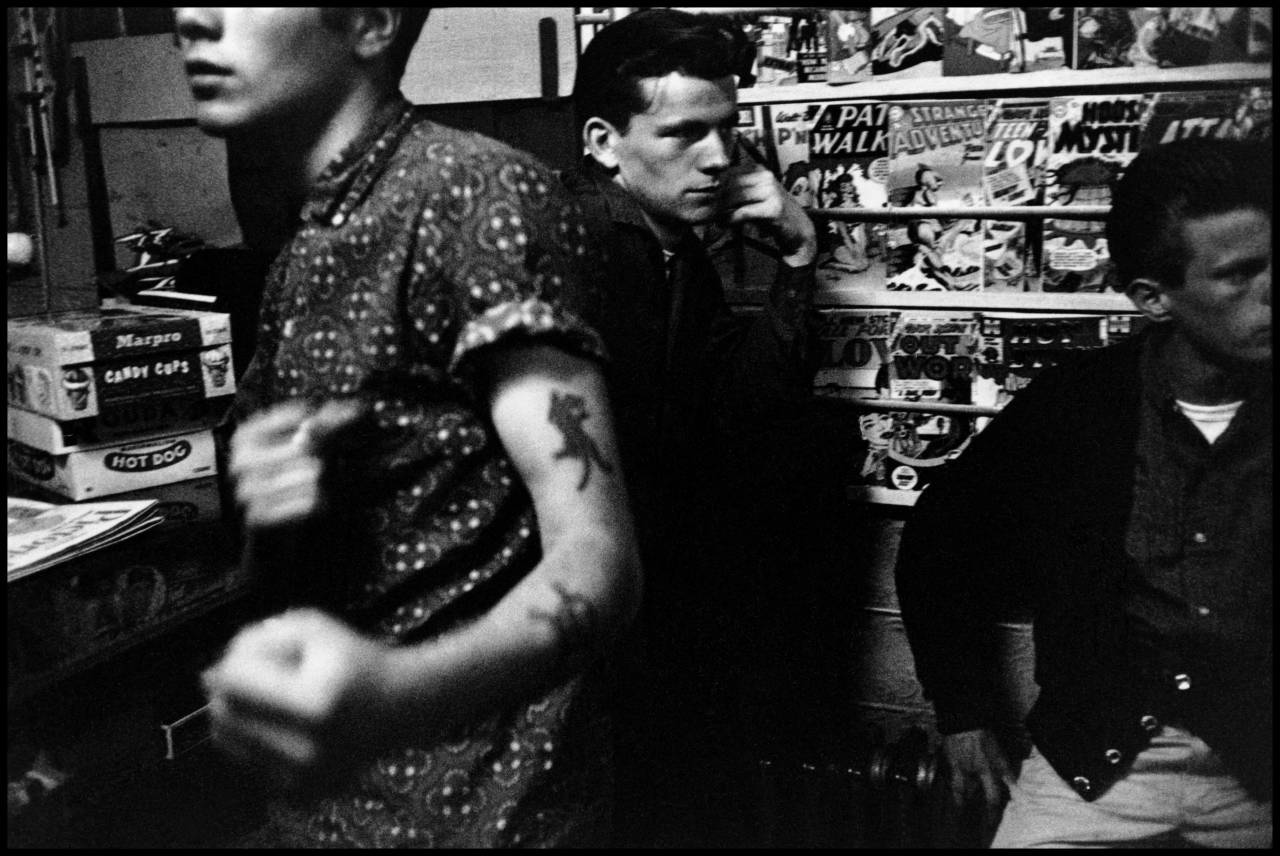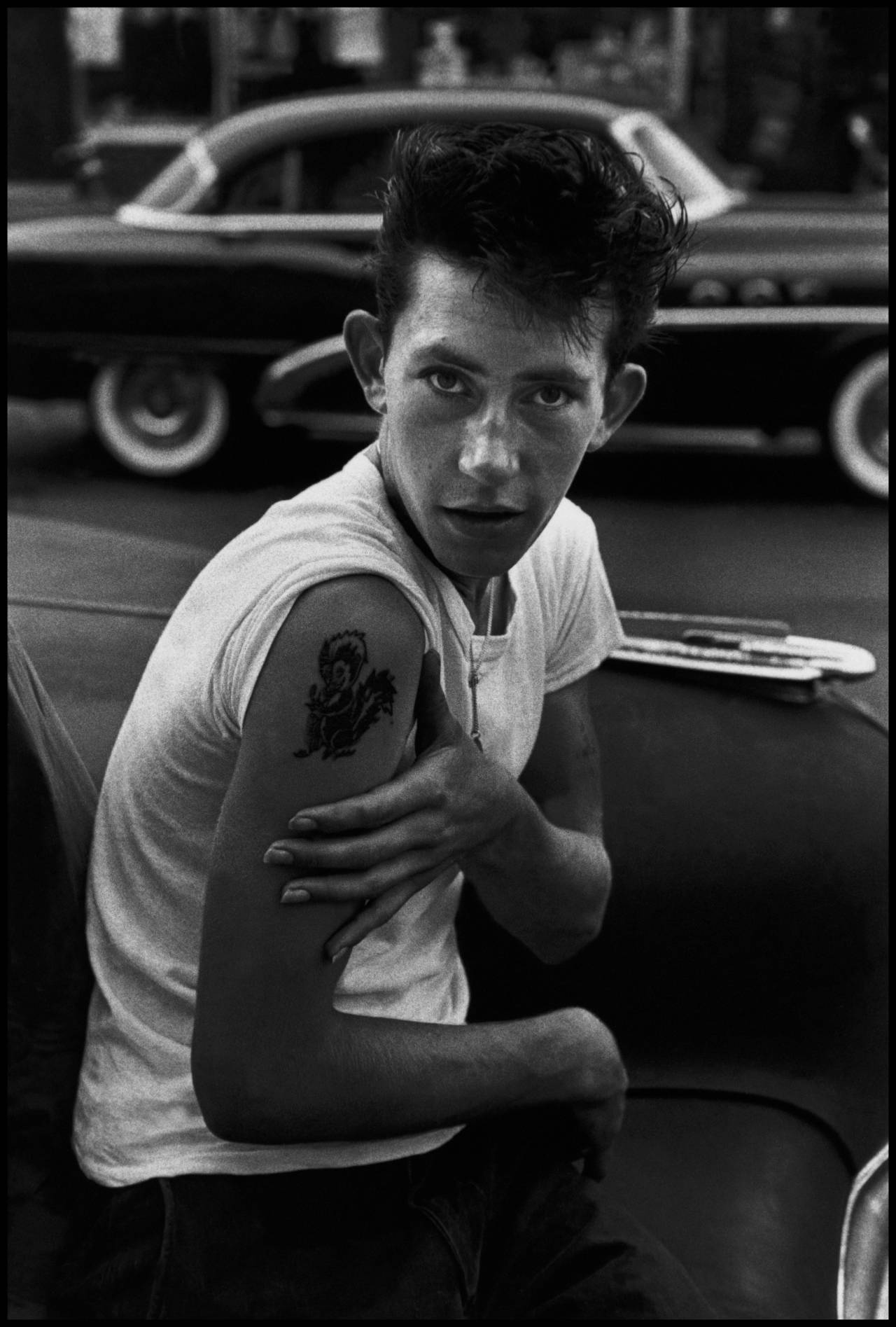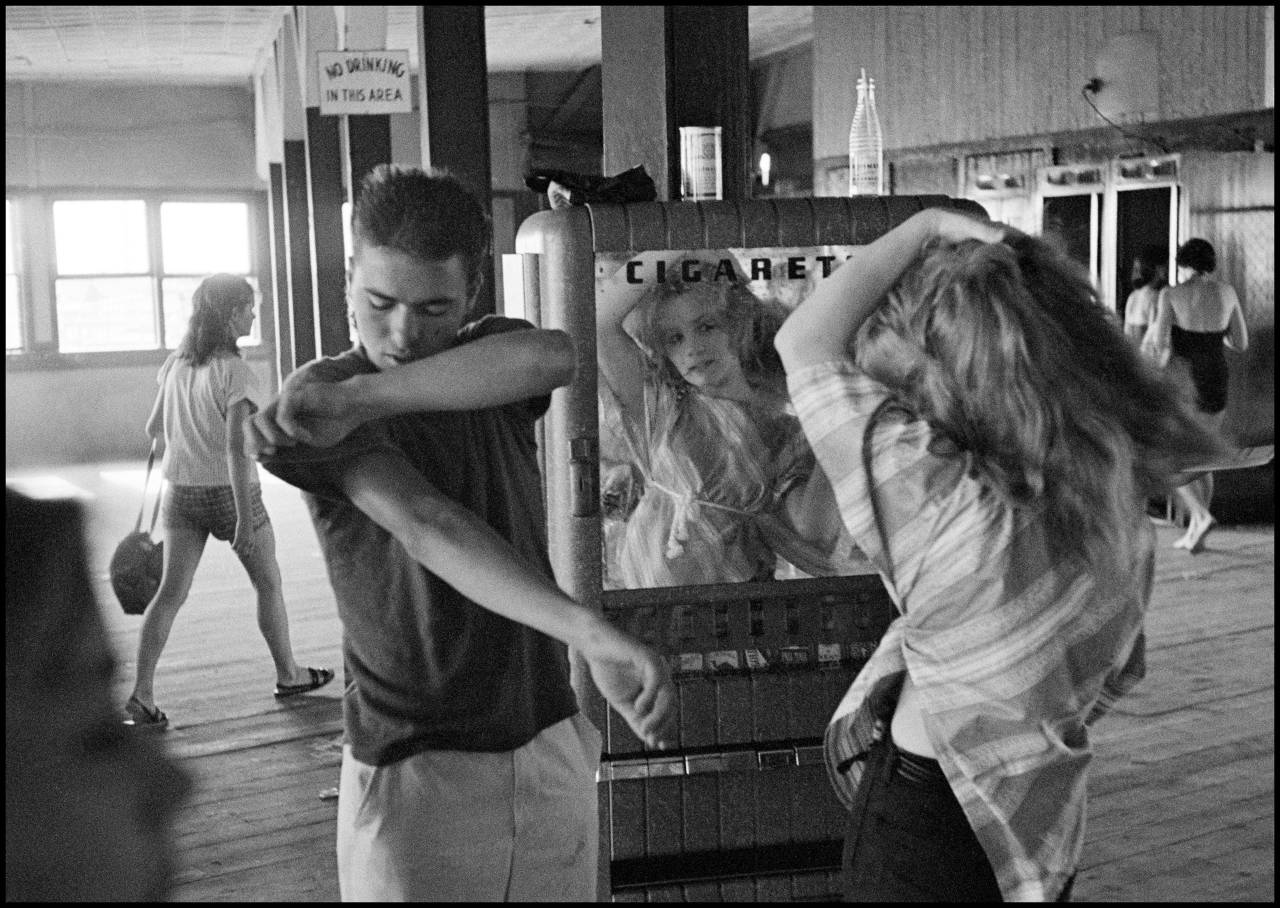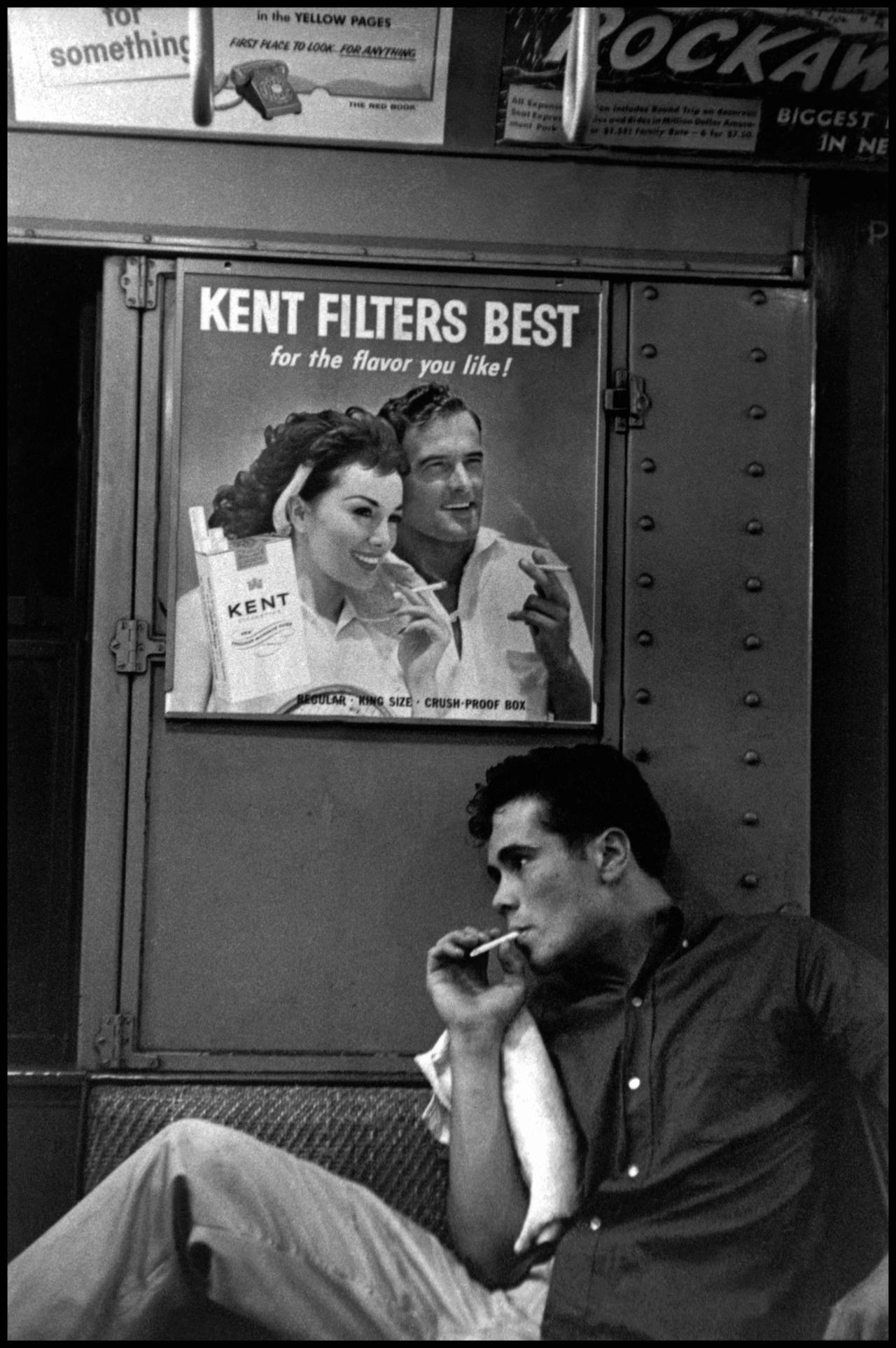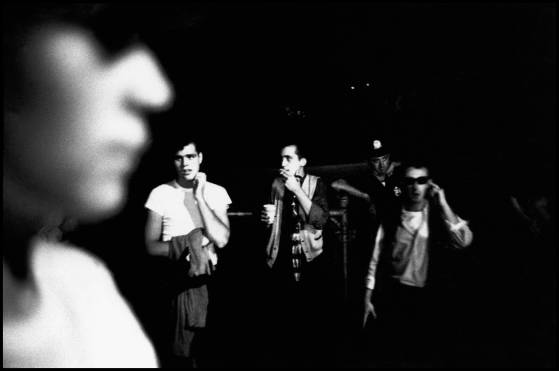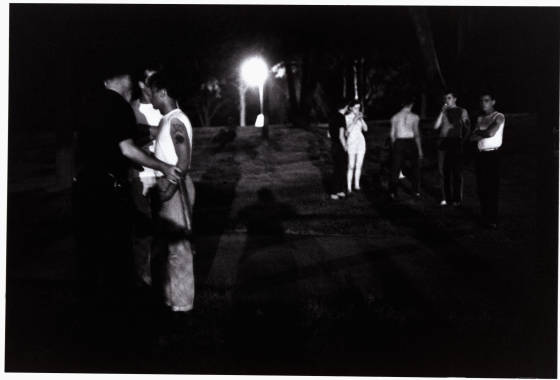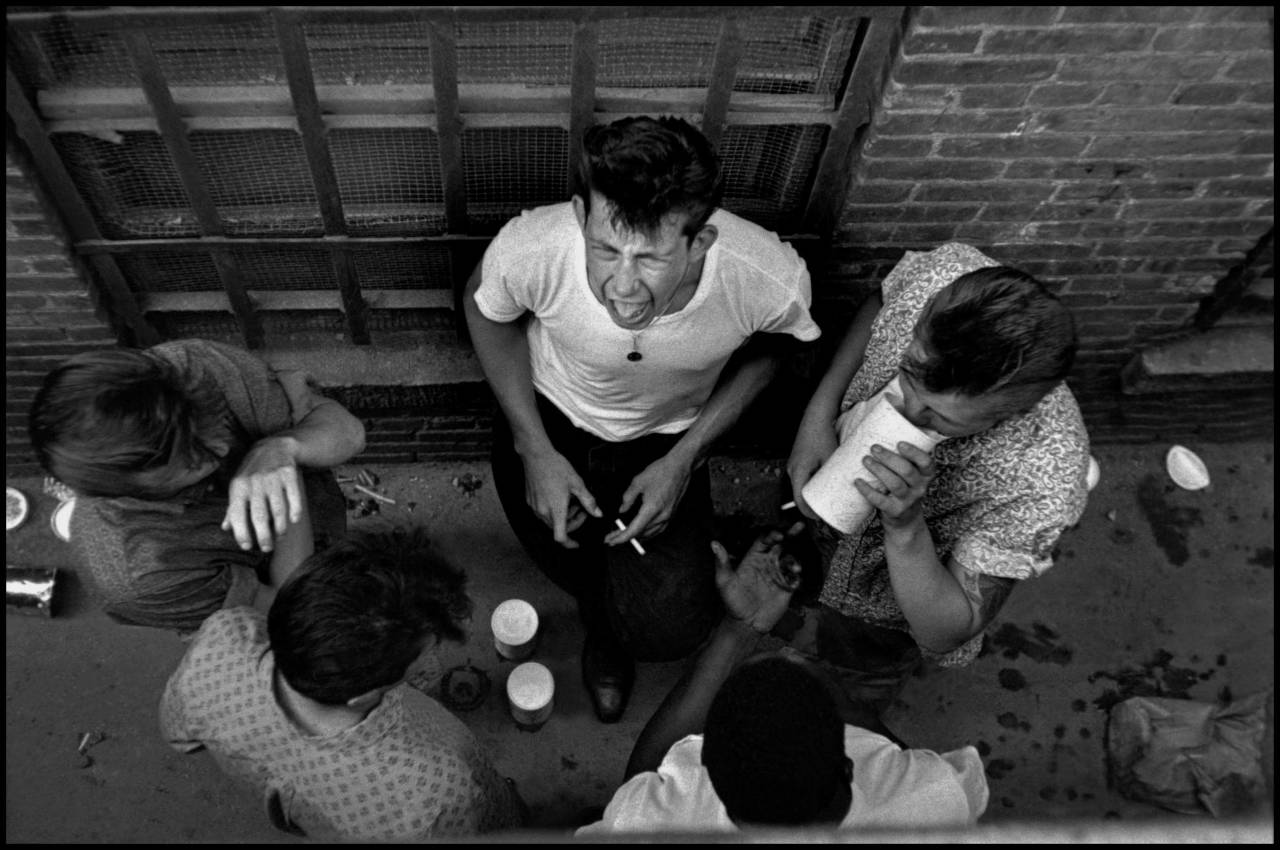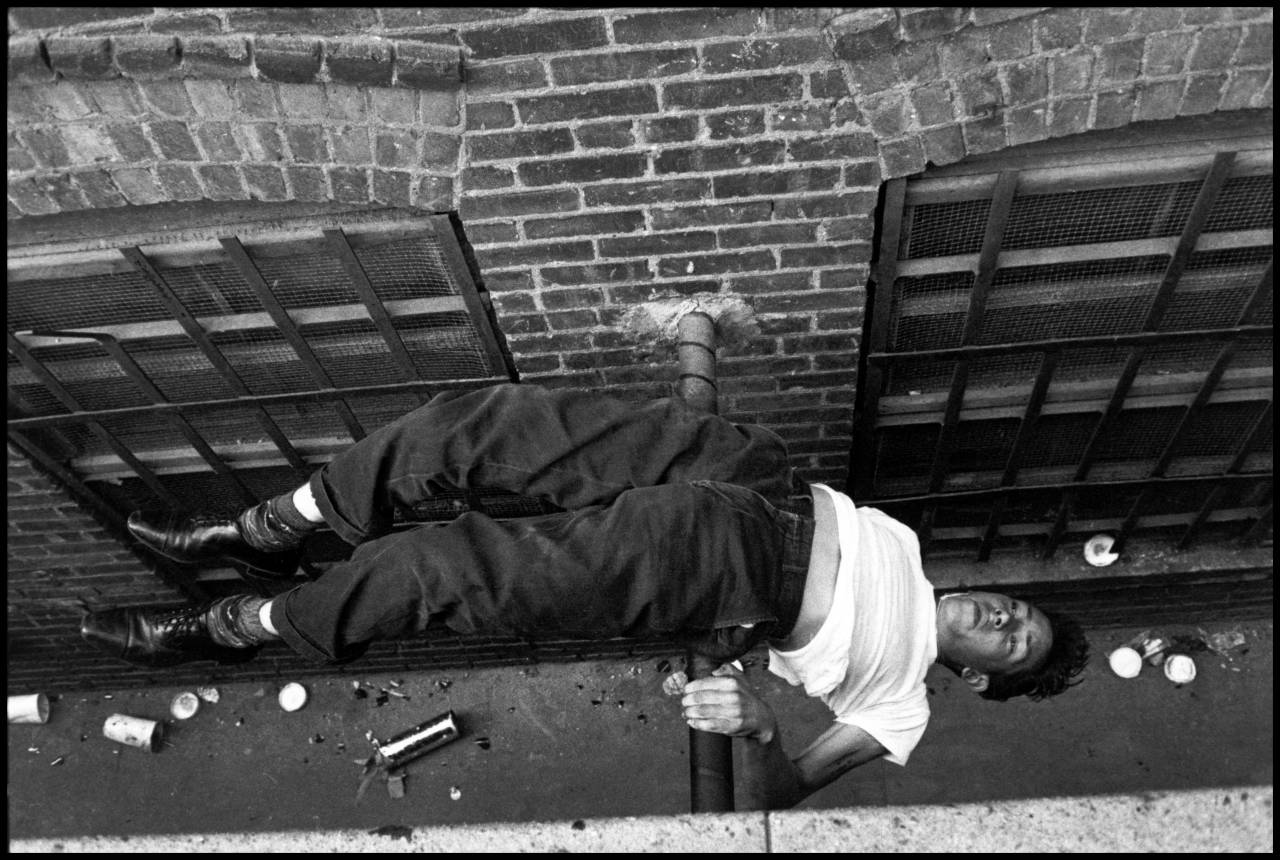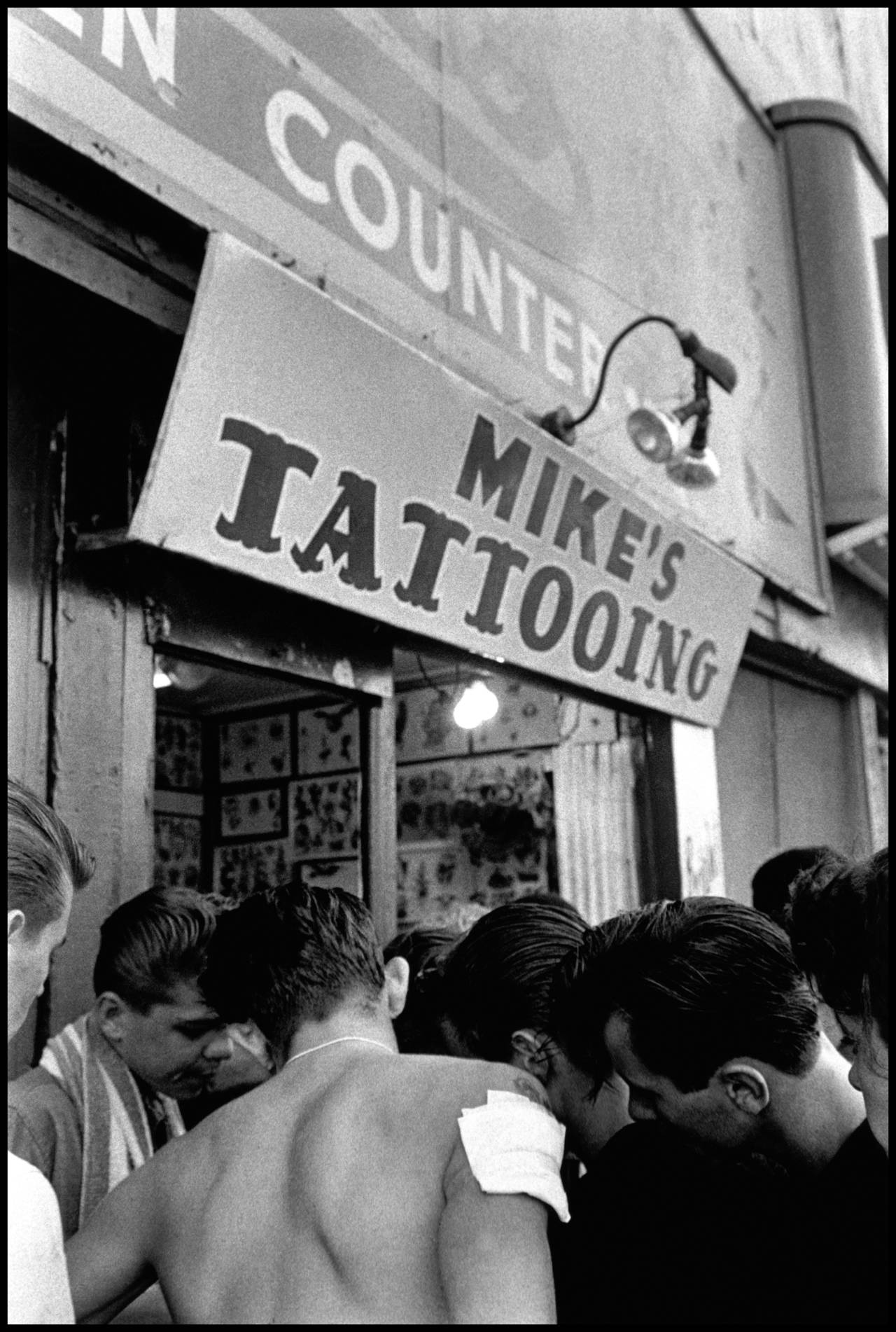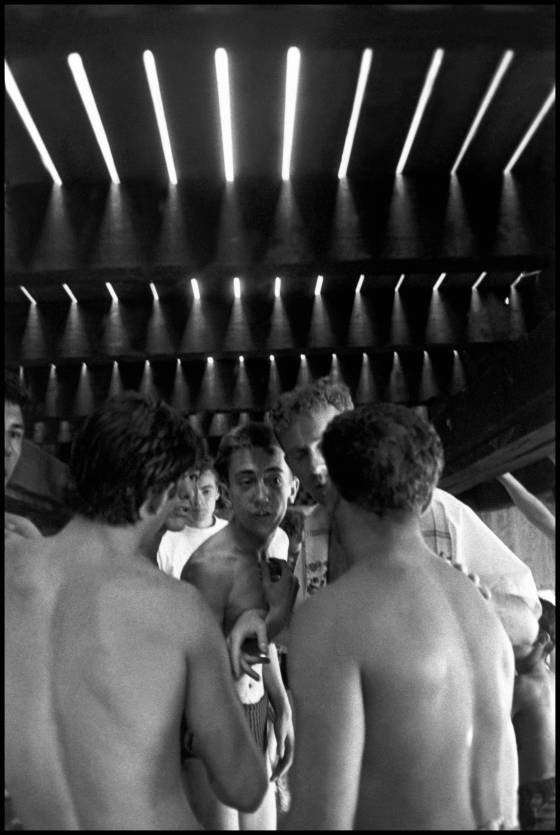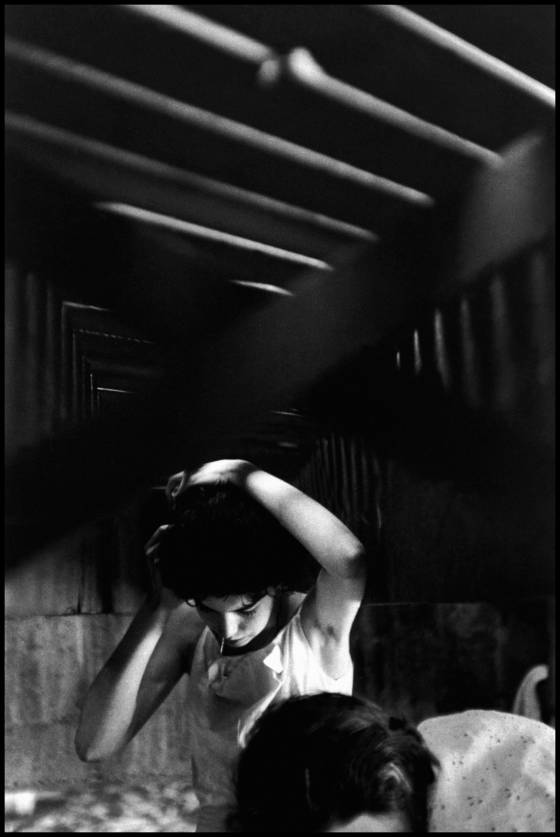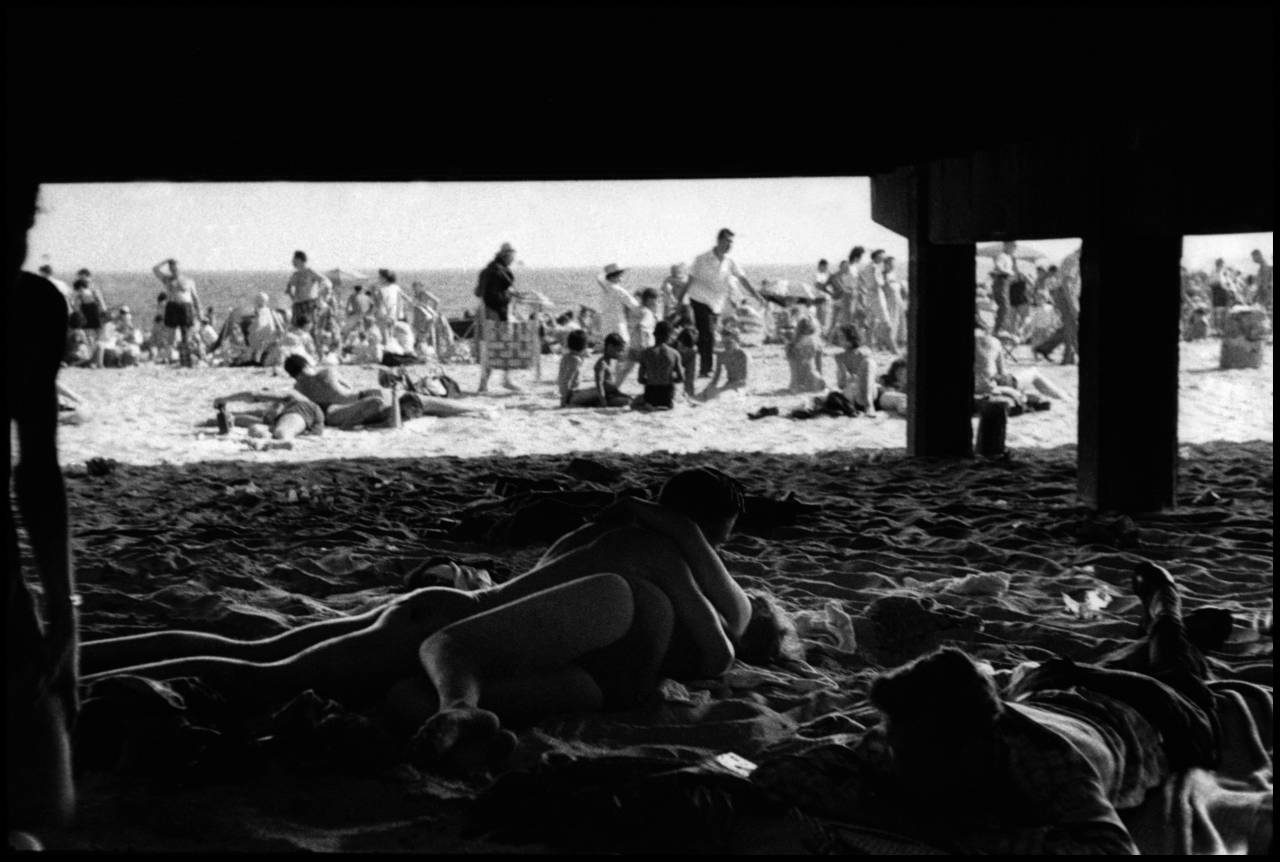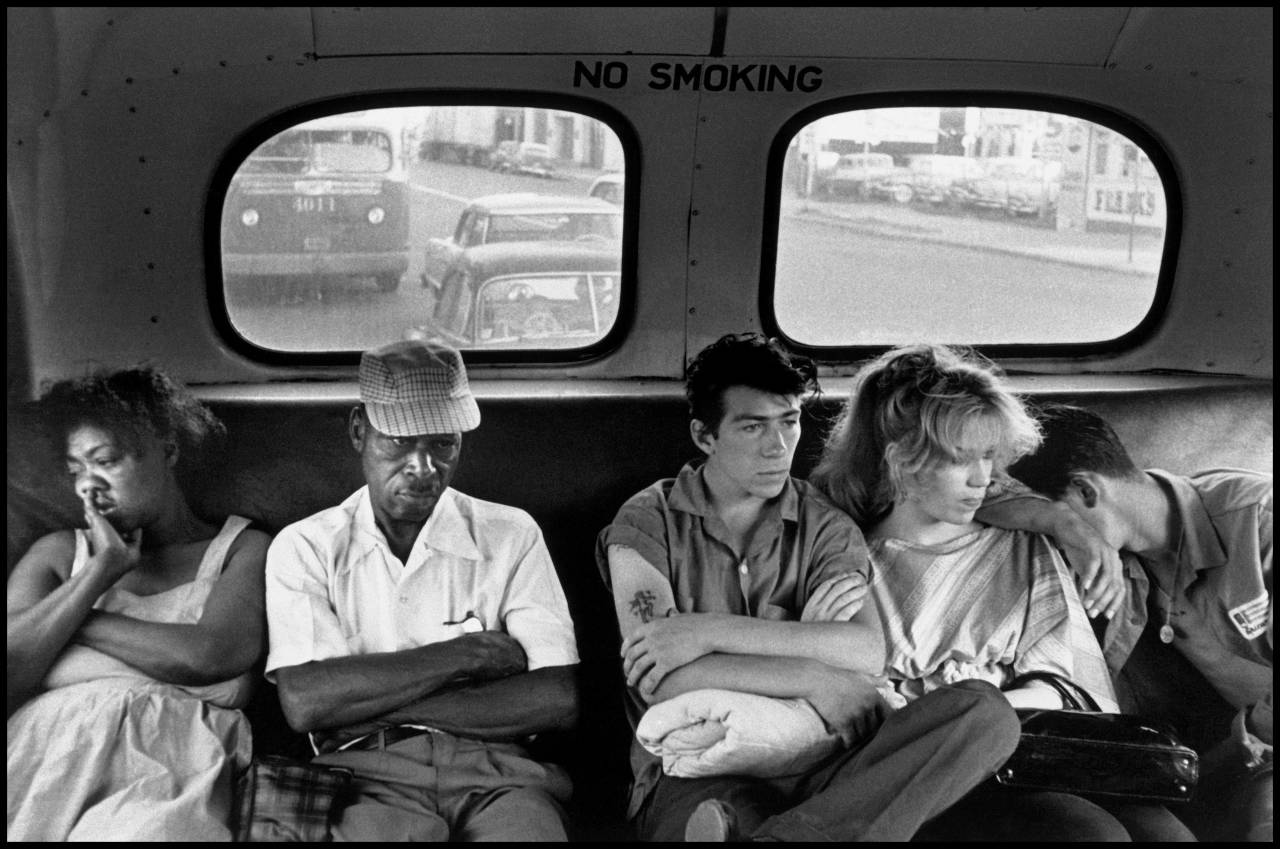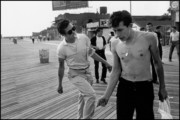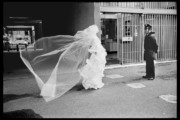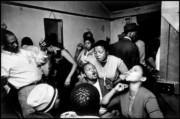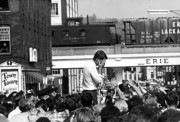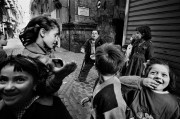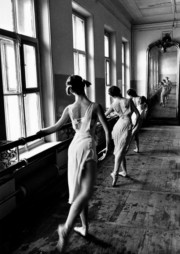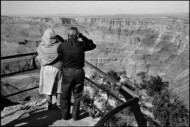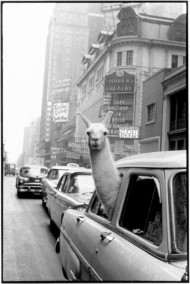Brooklyn Gang
A 25-year-old Bruce Davidson investigates a teenage gang in Brooklyn capturing the spirit of post-war youth culture in New York
In 1959, Bruce Davidson read about the teenage gangs of New York City. Connecting with a social worker to make initial contact with a gang in Brooklyn called The Jokers, Davidson became a daily observer and photographer of this alienated youth culture. This work – his first major project, undertaken when he was 25 – not much older than the youths depicted in the work – became the classic photo project, Brooklyn Gang: a collection of images of tough people and tough lives that captured a vision of youth in post-war New York City.
Here we reproduce a selection of Davidson’s images from the project, alongside Emily Haas’ extensive and revealing 1998 interview with Bengie, a former gang member turned drug counselor. Bengie reflects upon the nature of the gang’s daily lives in the period in which Davidson was working with them – when Bengie was just 15 years old. The interview was originally published in Twin Palms Publishers’ 1998 book, Brooklyn Gang.
Signed copies of Brooklyn Gang are available to purchase on the Magnum Shop as part of the New York: Photographing the City collection. A number of Davidson’s photographs from the project are also available within the newly expanded New York Fine Print curation.
The Neighborhood
For the most part, we never had anybody that took any kind of interest in us. Many adults didn’t like us. We were a street gang and we sort of protected our turf, you know, our candy store, our park side, with the girls and that kind of thing.
I remember these pictures because I took Bruce up on the roof on 17th Street. I said, “Wow! The television antennas with the Statue of Liberty, what a great picture!” I remember saying to him, “I’ll get you up there.” I went up and opened the door because those buildings have superintendents that didn’t want people on the roofs. And I remember us sneaking up there. It was the first time I was on those roofs.
This was our block, I mean we owned the block. Nobody could tell us what to do or how to do it or anything like that. There was us guys, who were at this particular time, in 1959, fifteen, sixteen, and there was the older guys. There was a lot of them and there was a lot of us, and nobody could come on the block or bother us or anything like that. It was a very safe place to be, on the corner of 17th Street and 8th Avenue. I used to worry about who was going to come after me if I walked past 9th Street or even got into the park. We always worried, because then we were out of our little turf. This was the block. This was where the little Jokers were. This is where we started calling ourselves the 8th Avenue boys.
We always played stickball. We would chose up sides in the stickball game and the big guys would take some of the little guys on one team and some of us on the other. We used to call it “Off the Point.” The point was a piece of slate that was sticking out of the factory, and we would hit the ball off that, and the sewers were the bases and the sidewalk was another base. Some people yelled at us, most didn’t. Nobody’s car would get dented or banged up. We watched over the block. It was a great time. I always felt safe on the block.
"Nobody's car would get dented or banged up. We watched over the block, It was a great time. I always felt safe on the block"
-
When we had fights between each other, we really weren’t allowed to hurt each other. Physically, we were allowed to make somebody give up, like grab them in the choke hold, but we weren’t allowed to kick or punch anybody in the face. It was like a surrender thing, and then you gave up. I was probably all of about a hundred pounds if I was that much, five three or four, and I was a very tough cat: you didn’t give up or say “uncle.” You’d stay on the ground sometimes for an hour with somebody holding you. I was one of the guys that just didn’t give up. What it used to wind up is, nobody was tough. We were all tough, but nobody was the toughest, although we knew. which guys in the gang were tougher. I knew plenty of them were tougher than me. I would imagine I had some of them scared of me, too. And that’s what we did. We didn’t fight one another because we knew what one another would do. We saved it for other people, other gangs. And if one of the bigger guys – I don’t mean the older ones, I mean one of the bigger guys in the crew – would pick on somebody else, then four or five of us kind of went up on him and told him, “Knock it off. We’re a crew and we don’t fight with each other.” And really that’s the way we stayed safe.
I would imagine, thinking back now, we didn’t humiliate anybody, any one guy, because they were our gang. If they were found out to be some kind of punk, they wouldn’t be allowed to hang out with us. We had a lot of words, we had these “ranking contests.” We would rank each other out, put each other down, and that determined who or what you were. And for the most part, Petey was pretty good at that. He had a real good sense of humor. Petey was like my best friend. We hung out a lot together. He had a bandage on his head from the fight that we had in the park. He got stitches and they shaved his hair – that black curly hair – he was buggin’ out! We sold fireworks out of his basement when we were fourteen, fifteen years old and made lots of money – thousands of dollars. I was like the salesman. I was good at it.
"We still had to go to Mass on Sunday. And the statue with the Christ on the cross and the Blessed Mother, every time we passed that, no matter what, we would bless ourselves. This was our church, this was our parish"
-
We were all Catholic school kids. Some of us got thrown out, but it didn’t stop our families. We still had to go to Mass on Sunday. And the statue with the Christ on the cross and the Blessed Mother, every time we passed that, no matter what, we would bless ourselves. This was our church, this was our parish.
It was hard being in Catholic school when I was a kid. The nuns were tough, the brothers were tough. I didn’t like it at all. They were tough, they would hit you, and they didn’t teach you nothing. They took you up in front of the class, they put your hands up and they’d punch you out. I got thrown out of Catholic school when I was eleven and PS. 10 when I was fifteen. I went through Catholic and public school and never learned how to read or write till I got clean when I was forty years old. So I always had this resentment about the teachers and the nuns. Like why didn’t they know? Why didn’t they help me? Why did they put me in the back of the class? I was a little wise guy, which is the truth, I really was. Since the day I walked into school, at seven, I wanted to walk out.
But the church means a lot. My family were alcoholics, no education, very, very poor, and we used to get money from the church to eat. I never thought anything of myself. If you said something about me, I had to fight you. And there were many times that people said things about me that hurt my feelings, but I didn’t know how to do anything but either curse at you or fight, because that was my only means of defense at that particular time.
We really weren’t into heroin at the time. We were drinking beer, smoking pot, maybe popping a pill here and there. Johnny and Jimmie were some of the older Jokers, but they watched over us. Later, the whole family, all six of them – Charlie, Aggie, Katie, Jimmie, the mother, and the father – died, wiped out, from drugs. It’s amazing because at this particular time, if you see Jimmie, he’s like the “Fonz,” like James Dean – handsome. He was good looking, he had the women, and he was always working on cars.
From seven, to fifteen, to nineteen years old, to the fathers of everybody – they all were teaching us about the gangs. The older guys hung out in the bar directly across from the candy store. When they had their dice and card games – especially the dice because they used us to roll the dice – they paid us a buck as they won so we would make money. That’s how we learned to gamble, throw dice, and play cards on the corner. The older guys would ask us to play cards so they could take our money, too, if we had any. They always did that if we had money, but they used to buy beer for us in the stores when we were fifteen. If we said we wanted a case of beer, they’d say, “No, we’ll get you just a six-pack.” And naturally, we got a six-pack from this guy and a six-pack from that guy.
Prospect Park
Mostly, we used to save up money until Friday night when there were dances in Prospect Park. We all needed a couple of cans of beer to get a little bit high, to go up there and talk to the girls and dance. The bandstand would be up on 11th Street and 9th Avenue. On one side of the park was South Brooklyn and on the other was the Jokers. We used to look at each other from across the field, 9th Street was theirs and 11th Street was ours, and nobody walked around unless they wanted to get their ass kicked. The guys would dance with the girls to see who danced the best. It was who dressed the best on Friday night, which guys were dancing, and who was making the most noise. At the end of the park dance, a fight always managed to break out somewhere along the line. We would walk out of the park and catch one of them walking around. Naturally, some of our girls liked their guys and some of our guys liked their girls. It was like a contest, it really was. It became like: “who could get that girl.”
I liked a girl from South Brooklyn. It was pretty dangerous because I used to have to take her home into their territory. I had to act like I was cool and wasn’t afraid. Meanwhile, I remember being terrified, and them catching me a couple of times and my getting beat up. And I remember going back and getting a couple of them. So when I walked Pat home, I’d be in the doorway on 8th Street and when I went to leave l’d say, “Naw, don’t worry, I’ll be all right.” Couldn’t wait till I got from 9th Street to 10th Street to 11th Street to 12th Street. As I walked those blocks into my territory, I felt myself breathing easier, and when I turned around and didn’t see nobody behind me I… Whew! made it. It was such an intense thing to do, walk into the neighborhood with the girl and then tell everybody, “Pat’s my girlfriend, she’s from South Brooklyn.” It was a big deal.
Helen’s Candy Store
Helen’s Candy Store on the corner of 17th Street was really like our home away from home because we had Helen in the store. Helen was like our mother. And nobody would bother Helen because of Bobby, her son, one of the bigger guys (Later, he was shot seven times – dead). Nobody ever disrespected her. If Bobby ever heard anything, he rushed to tell us very quickly “I’ll break your face!” So we were cool in the store. All the information you wanted during the day was there. You went in, “What’s happening?” That’s what you’d say, “What’s happening?” The big guys used to think they owned the store, but Helen always favored us because we were the younger guys. She’d make us our egg creams, lime rickeys, ice cream, and give us the penny candies, the licorice, the comic books, and let us hang out all the time. Helen was always fighting with us about putting Superman, Batman, and all the stuff back on the shelves, “Put them back, put them back. You’re reading it, you’re not going to buy it, put it back.”
The funny part is I never knew how to read, but I would look through things pretending I did know. I’d put my hand on my head like I’m just thinking. Everything I did was like a fake. I had to put it on. You can imagine hanging out with guys that all went to Catholic school, all knew how to read and write, and would say to me, “Look at the comic book. Look what it says here.” And not being able to fucking know! It was very painful. So I would always put on moods that said, don’t bother me. No, I don’t want to look at your book. The moods that I put myself into used to tell you not to talk to me, don’t ask me questions like, “Here, read this joke,” or “Look what it says in the paper.” I would say, I’m not interested in that. Fuck that, get it out of here, don’t fucking bother me.” I never let anybody know. After forty years, when I got clean, some of the people who I know today that were hanging out in the candy store, just recently in the last couple of years, found out that I never knew how to read or write. They never knew.
"When Bruce would take a picture of me, I would just stay in the spot that I was in, I would never fake it. Sometimes I caught him with the camera and I would just say, fuck it. What am I going to do, smile? I wanted to tell people how sad I was"
-
I see a fifteen-year-old kid who looks like he’s in a lot of pain. I see a kid that wished he was dead a million times. I hated myself, didn’t like myself at all. And a lot of what I did when I was fifteen, sixteen, seventeen, eighteen was on like a suicide mission, even up to being a drug addict. It always meant that I was never afraid of dying, never, until the day I got clean. When Bruce would take a picture of me, I would just stay in the spot that I was in, I would never fake it. Sometimes I caught him with the camera and I would just say, fuck it. What am I going to do, smile? I wanted to tell people how sad I was.
Helen used to get crazy because some of the guys would carve their names on the Coca-Cola machine. Petey always had a thing about putting his name everywhere. Helen’s son, Bobby, punched him, gọt him in the phone booth and beat the shit out of him, saying, “Well, who put it there?” And Petey would go, “I don’t know, I don’t know!” It was funny because we said, “No, don’t put your name here. You put your name here, and he’s going to knock your ass. And Petey carved it right in the Coca-Cola machine on the counter. I’ll never forget him getting in trouble for that.
We never stole anything from Helen. She had little bills for us, we had little credits. We had tabs in the store saying like who owed $1.55. But at that time, for that amount, you wound up with a couple of sodas and ice creams, maybe a frappe or a sundae. The store was just a great place to hang out, and we would for hours, wondering what to do, where to go, waitin’ for the phone to ring, whose girlfriend was gonna call.
Junior was the Don Juan of the neighborhood. He was a really good-looking guy, very, very handsome. He was the book reader, read everything, walked around with a copy of Ginsberg’s Howl in his back pocket. He was the Romeo of the group. Lefty had all the girls too. We always wondered why the girls liked him. We never thought he was good-looking, but all the girls loved him. It was amazing.
Hanging Out
Junior was the first one to get tattoos. He’s got the tattoo of the doll on his back. That’s the one I got on my legs. We both got it at the same time. Junior with his snakes, and the hearts, and the cobras; he always had the cobras. We were always rolling our sleeves up because we had tattoos. We had to let the girls see the tattoos. Or the guys, cause they resembled like you were tough, and it made you older. If you were sixteen, you could say you were eighteen. It was like a badge. It meant something. People would say, “Oh, you got a tattoo!”
I was very shy with the girls, but when I was sixteen I had two girlfriends at the same time. Because one could stay out later than the other, I would take one home and then go out with the other one. That was like the thing at the time, to have a couple of girlfriends. Cathy was beautiful like Brigitte Bardot. We used to call her the shaggy dog. I remember Cathy living up 20th Street, in a rooming house with her mother. Cathy would always come out immaculate. When Cathy was like thirteen, fourteen years old, she was the hottest thing you ever saw in your life. She had a knockout body, really knockout. Everybody turned their eyes looking at Cathy. We were glad to have her hanging out with us. None of us ever felt that we could be with her, except for Junior. She loved Junior, she loved him. Cathy always was there, but outside. She was beautiful. Then, some years ago, she put a shotgun in her mouth and blew her head off.
"It was very sad to see her because she was so sad. She was always sad, always fixing her hair."
-
We were noisy bastards at night. We would go under somebody’s window that we didn’t like and hang out there. We wouldn’t make noise where we knew we were going to get in trouble, like Petey’s mother would be yelling at us out the window, “What are youse doing here?” Sometimes they’d even throw water out the window at us if we were making too much noise – “We’re going to call the cops!” – cause we used to play cards until two, three, or four in the morning. And not for money! We would play Brisk or Casino in teams. Like me and Petey were a team, and we never had any other partners for years. I only played with Petey, cause we knew all our hand signals, all the little moves for cheating: touch my hand, hit my eye, a cough, which means you had the king, trump, ace. Each card was a different noise. We played for hours on end. And if Petey played with somebody else, I wouldn’t play with him again, because I figured he gave the other guy all the signals.
Down the block from the candy store was the grammar school, P.S. 10. Some of the teachers were cops and correction officers They let us play basketball and have dances. Although we were a little older, they still let us in because we needed a place to hang out. There were the little 45 records like “At the Hop” and we would dance the Lindy. We used Vaseline petroleum jelly to make our hair stick like iron in a pompadour. We combed our hair constantly, wore sunglasses, and all thought we were Marlon Brandos. We had a lot of parties. Somebody would say, “I’m going into the army,” so we’d have a party for them, then at the end of the night, “Bullshit! I ain’t goin’ into no army.”
We were always trying to act tough. You weren’t allowed to smoke on the train, so we would say, “Yeah, sure,” and we would light up. It’s funny because Kent was the first cigarette I ever smoked. We liked getting on the train, going to Coney Island, all kinds of freak shows. We used to love that, going to Hubert’s Castle Flea Circus on 42nd Street. That was wild.
I remember a little sandwich shop down on 5th Avenue and 13th Street. There was another crew down there, the 5th Avenue guys, and when we went we’d combine our gangs and the girls. It was a cool place to have a sandwich and listen to the jukebox.
We used to hang out in Prospect Park all the time. We did a lot of drinking and sleeping overnight in the park. We thought we were so cool wearing those sunglasses. The cops with their bats would push us along, tell us to move. We were very defiant. If we moved, we moved ten feet. Then they had to tell us to move another ten feet. We’d kind of like move around in a circle and come back to where we originally started. The cops were mean at that time, but then we weren’t the best of kids either.
One of the younger guys, at seventeen, was killed standing on the swing, fell off onto the back of his head, went to the hospital, and died. He was the first of the gang to die. We’d get drunk and fall asleep, and nobody would wake you up. Then it’s morning and your mother’d kill you.
"Another place we drank was "the hole on 18th Street. It was only 3 1/2 feet wide and 30 feet long. There was a bar that we used to spin around on, that was like our "high bar." We'd all do tricks and flips on this thing"
-
Another place we drank was “the hole” on 18th Street. It was only 3 1/2 feet wide and 30 feet long. There was a bar that we used to spin around on, that was like our “high bar.” We’d all do tricks and flips on this thing. You had to climb up on the windowsill to reach the bar, about six feet in the air. It might have been a water pipe because it came in from the street across the hole to the factory basement. We would meet and drink here before the park dance. This was the spot.
We used to have the big guys buy full quarts of beer for seventy-five cents. “Get us four containers, here, buy one for yourself.” We would have to buy one for them. They would take the containers out of the bar, walk a block, go around the comer, all the time with us following behind, then hand it to us. Then we’d go down in the hole open one at a time, and pass it around until they were empty. It was amazing because our mothers could walk past there and see us down in the hole, but for some reason they never came over and said “Get out of there! Stop drinking!” Not even the cops – they would come down the block, but couldn’t see us down in the hole. Lefty always used to make faces when he drank. He would drink and spit.
"Underneath the boardwalk we used to hang out with the beers, the smoking, the fighting, and the sleeping. We'd come down on a Friday and sometimes we'd stay the whole weekend till Monday, down on the beach, me, Lefty, Junior..."
-
Coney Island
Mike’s Tattoo Shop down in Coney Island was famous. Lefty and me wound up the first two times getting the same tattoo. He got “Lefty” with stars around it. I got “Bobby” with stars around it. The next time we both got the skunk, but they put “Stinky” on mine by mistake. Stinky, which stuck for years! Every time somebody saw it – “Oh, so you’re Stinky.” You’re getting the tattoo, sitting there, but turning your head away, and the guy keeps drawing – a big mistake! My first was “Bobby.” They said, “Get your name.” So I said, “No, I don’t really want my name.” And then when he put it on, I hated it forever. It took forty years before I got it covered up with a Merlin. It’s hard to find a tattoo guy that will cover up someone else’s work. The first time you get a tattoo it’s scary. I was sitting back with a cigarette like it’s nothing. Meanwhile, it was killing me. Petey got a big tattoo, an enormous eagle on his arm. He used to tell me, “You got fat arms, you gotta get a big tattoo. You going to get a little tattoo on your big arm?!”
It’s a shame the way Lefty died. He was a pretty tough guy in the gang and then he went to jail for about a year. He came out and he just lost it. He wasn’t the same guy. Something happened and nobody knew what. He was getting beat up in the neighborhood. This never happened before. We were telling people, “Leave him alone, man.” We protected him a bit, but he caught a couple of bad beatings and lost his reputation. He ate a lot of pills one night and never woke up. His mother found him dead, OD’d in bed at nineteen. He was the first in the group to die from a drug overdose.
The Ocean Tide Bar was where we hung out in Coney Island. It’s gone. And underneath the boardwalk we used to hang out with the beers, the smoking, the fighting, and the sleeping. We’d come down on a Friday and sometimes we’d stay the whole weekend till Monday, down on the beach, me, Lefty, Junior. The girls would stay too. Some would go home and come back in the morning, some would come back in two hours, “I just got to go home and I can sneak back out.” They would do like that; it was pretty cool. There’s a couple of crews that we hung out with down there, and every once in a while, somebody broke, as they say. Somebody might have said something to somebody’s girlfriend. We had a lot of fights down there with the Coney Island Gents and others, but it was hard running underneath there because you could hit your head on the concrete.
"I remember stealing cars and driving down there. We'd drive the car under the boardwalk and bring it right onto the bay and leave it there. The other big thing was carving your name somewhere"
-
We would light the fires and bury all the cans of beer. We tried to keep the place clean because the cops used to get mad at us for making a mess, so we kept it good. I remember stealing cars and driving down there. We’d drive the car under the boardwalk and bring it right onto the bay and leave it there. The other big thing was carving your name somewhere. No matter where it was, we used to carve our names.
Beautiful Cathy was there, always with her honey, Junior. I don’t think Cathy ever wore a bathing suit on the beach. She was always dressed in her nicely ironed clothes, and her hair and makeup was something. She had hair down to her ass. It was very sad to see her die. It was very sad to see her because she was so sad. She was always sad, always fixing her hair.
Interview by Emily Haas, New York City, June 1998


